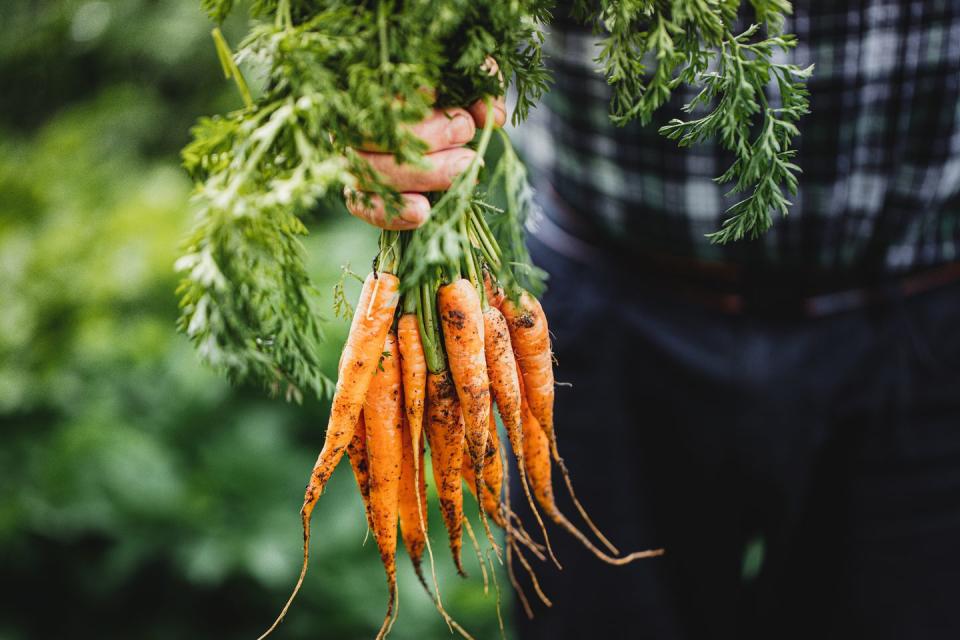Here's How to Plant a Late-Season Vegetable Garden for the Fall
Maybe you never got around to starting your vegetable garden this spring, or perhaps you’re swamped with an abundance of zucchini, tomatoes, and basil right now. You might even just prefer to do your gardening outside of the sometimes uncomfortable conditions of summer. Either way, you can extend your gardening season by learning how to plant a fall garden. In fact, plenty of veggies you can grow in your home garden—such as greens, cabbage, kale, and root vegetables—love the milder temperatures of fall! Plus, there's less heat, humidity, and even bugs to deal with. But you can’t procrastinate: Fall garden vegetables must be planted in the heat of mid to late summer in order to for them to mature in time for an autumn harvest.
Before planting a fall garden, you can first start by deciding on your vegetable garden layout then digging up any summer crops that are done for the season. That includes any raggedy salad greens that have gone to seed from spring plantings, garlic or onions you haven’t harvested yet, and maybe even tomato plants that have succumbed to disease and have no green leaves left (you still can salvage the fruit by picking when green, and stashing in a brown paper bag until ripe). Carrots and potatoes also are ready by now, so pull them out to make room for the next round of planting. Weed, clean up old vegetable foliage and dispose of it, and don’t compost any plant material that is diseased.
Once you're ready to go, buy seeds then apply the tips below for planting a fall garden with delicious vegetables.

Can you start a garden in the fall?
To ensure a successful harvest, you’ll need to plant fast-growing crops that will have enough time to mature before the first frost. For most regions, this means you should start planting your late-season veggies in August. This will allow your crops to size up while growing conditions are still satisfactory. The plant tag or seed package should give you more information on maturing time. From there, count backwards from the first expected frost date in your area to determine the last possible date you can plant. To be on the safe side, back that date up an extra week or so, because fall-harvested veggies grow more slowly as the days get shorter.
Wondering if it's too late to plant a fall garden? Not quite! In fact, you're just in time when it comes to planting something like pumpkins. Some other favored fall veggies like broccoli, carrots, cabbage, Brussels sprouts, cabbage, and cauliflower should be planted 10-12 weeks before first frost or during mid-summer. Quick-growing crops such as root vegetables and most greens can be planted late-summer and some even into late September.
If you’re not sure when the first frost occurs, your local university coop extension service can provide an estimate. (Find yours here!) Of course, nothing’s guaranteed. Frost can come early or later than usual, but this will at least give you an idea of when the season is over. In warm climates, you can plant most vegetables well into late fall.
What fall crops should I plant in my garden?
Some vegetables including lettuce, spinach, and mustard greens plus root vegetables such as radishes, carrots, and turnips can still be planted as seeds because they mature fast and have plenty of time left to grow this season. Others vegetables, such as broccoli, cabbage, and cauliflower are better planted from transplants. However, it’s not always easy to find seeds or transplants in the heat of summer when the big box retailers start switching over to selling fall plants such as mums. Shop online or check with small growers and nurseries, which often still have what you need.

What plants do well in the cold?
Some vegetables don’t mind the cold at all and will keep on going until a hard freeze. For example, many types of kale, including Red Russian and lacinato, are perfectly fine with frost. The same can be said for spinach, Swiss chard, Brussels sprouts, garlic, broccoli, arugula, leeks, and plenty of others. Many types of peas also prefer cold weather. Studies show that vegetables containing the pigment anthocyanin, which gives them their vibrant red or purple coloration, are more resistant to rots caused by winter weather. This includes veggies like red cabbage, red radishes, purple cauliflower, and black carrots.
Here's another tip: It’s also possible to get a few more weeks out of your garden if you’re expecting an early frost. Just drape floating row covers (or an old sheet if you're in a pinch) over sensitive plants. You can also invest in a plastic tunnel to make a mini-greenhouse that will protect cold-hardy crops such as spinach well into early winter.
You Might Also Like


